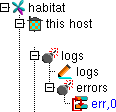Administration
An Administration Manual exists that explains how to configure and manage the flexibility in Habitat. However, some administrative information is useful for users to understand and some select topics are briefly covered below.
Replication
Habitat has the ability to replicate its data to a central repository (and collect data waiting for it). The replication is carried out by the a job within clockwork, which updates two tables once replication work has completed.
The state table (called rstate,0 in the ringstore) is presented as replication->state in the choice tree. It shows the state of replication rings and the observed sequences with their times locally and remotely.
Log messages as a result of the replication process are shown under replication->log in the choice tree (rep,0 is the ringstore). These are time stamped messages showing information and errors in replication process.
Logs & Errors
All jobs in the clockwork collection agent have the ability to generate error messages (like stderr in Unix). By convention, all jobs use the same ring to store their errors (the ring err,0), and this is presented under the label logs->errors in the choice tree. The log choices for the current host are shown below (habitat->this host->logs->errors->err,0).

Additionally, some jobs use the same ring to store non-error logs, although this is a smaller number than combine for errors. The ring in this situation is log,0 and is presented as logs->log in the choice tree.
Jobs
The collection agent clockwork uses jobs in a table to govern its activities. This is stored in a ring called clockwork,0 and presented under the node jobs in the choice tree.
The columns and meaning of them are shown below:
|
Start |
The number of seconds after clockwork has started before this job should start. A value of 0 starts the job as soon as possible after running clockwork |
|
Interval |
The number of seconds between successive runs of this job |
|
Phase |
Not currently used |
|
Count |
The number of times that this job should repeat. A value of 0 will repeat until clockwork is terminated |
|
Key |
The name of this job, useful for identification in logs |
|
Origin |
A text description of the job's owner, useful in larger job tables and typically their e-mail address |
|
Result |
The route to which results should be sent (cf stdout in Unix) |
|
Errors |
The rout to which errors should be sent (cf stderr in Unix) |
|
Keep |
The number of slots to keep in both Results and Errors when creating the rings for the first time. Ignored when the rings already exist |
|
Method |
The job method, which at the time of writing may be one of probe, exec, sh, snap, tstamp, sample, pattern, record, event or replicate. See the Administration manual for more details |
|
Command |
The commands that are passed to the method |
Raw Data
All data recorded in ringstore are displayed in an unadulterated form under the data label in the choice tree. Each ring name is represented as a node, underneath which are nodes representing different durations.
All samples are concatenated and broken into rime ranges for display as charts or tables. No consolidation of sample durations takes place, unlike the standard views (such as this host->host data->system).
This is the only method for viewing non-habitat data held in ringstores inside ghabitat.
